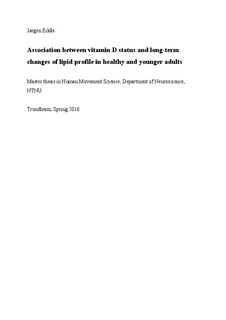| dc.description.abstract | Background
Dyslipidaemia is the condition of abnormal lipid levels and is considered a criterion in the
pathogenesis of arteriosclerosis. Vitamin D is considered to be beneficial for overall health, however the prevalence of vitamin D deficiency is a global problem. Increasing evidence indicates that a higher vitamin D level may be beneficial in terms of a favourable lipid profile. Substantial evidence suggests a beneficial effect of a higher level of physical activity on lipid profile. Additionally a few studies have observed an association between vitamin D levels and levels of physical activity. The objective of this study was to investigate the association between vitamin D levels and the long-term changes in lipids during approximately an 11 years follow-up, in young adults, and to study if physical activity modifies the association.
Material and methods
We included subjects aged 19-55 years who had participated in both the HUNT2 (1995-1997) and HUNT3 (2006-2008) survey of the Nord-Trøndelag Health Study in Norway. After excluding persons with abnormal lipid levels at baseline (HUNT2), a total of 1820 persons (1074 women and 744 men) with sufficient measurements on vitamin D, lipids and physical activity. We used linear regression to compute coefficient for the mean change in lipids from HUNT2 to HUNT3, among categories of vitamin D. Logistic regression was used to compute odds ratios (ORs) as an estimate of relative risk of developing low density lipoprotein (LDL) dyslipidaemia from HUNT2 to HUNT3 associated with levels of vitamin D. Stratified analysis was preformed on physical inactive and physical active people separately.
Results
The results showed an association between serum 25-Hydroxyvitmain D (25(OH)D) levels of 61,4-156 nmol/L and the mean changes of high-density lipoprotein cholesterol (HDL-C) (-1.27; 95% CI= -2.52 - -0.03) from HUNT2 to HUNT3, compered to the reference group (p<0.05). Serum 25(OH)D levels of 43,8-61,3 nmol/L was significantly associated with mean change in the ratio of total cholesterol and HDL-C (TC-HDL) (-0.10; 95% CI= -0.19- -0.00), and 61,4-156 nmol/L (-0.12; 95% CI= -0.21- -0.02) compered with reference group (p<0.05). Vitamin D as a continuous variable was significantly associated with mean change in TCHDL ratio (-0.06; 95% CI= -0.11 - -0.01) from HUNT2 to HUNT3 (p<0.05). Stratified analyses showed no significant difference by formal tests of nteraction between physical inactive group and physical active group. A large inverse association between serum 25(OH)D levels of 61,4-156 nmol/L and the new onset of LDL dyslipidaemia (OR= 0.75; 95% CI =0.57-0.97), was observed. No significant difference between the physical active and inactive groups was observed.
Conclusion
The results from this study indicate that a higher level of vitamin D is beneficial for a
favourable change in lipids particularly in HDL, TC-HDL ratio and a reduced risk of LDLdyslipidaemia, and levels of physical activity did not modify the association. | nb_NO |
